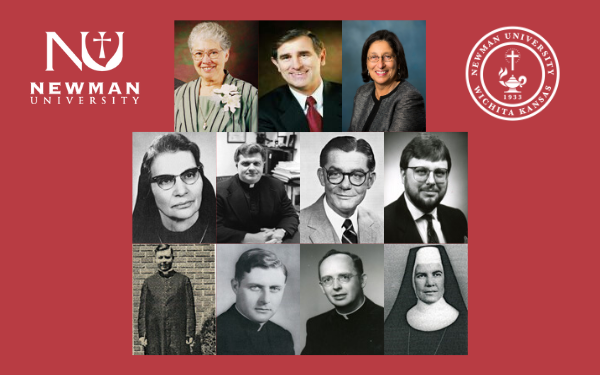In addition to being the face of their campus, a university president is responsible for a variety of tasks vital to the success of the university.
Newman University recently named its 12th president, Kathleen S. Jagger, Ph.D., MPH. From the time it was Sacred Heart Junior College to the present day, each of Newman’s presidents served to match their personal missions to that of the university, and each president’s term holds testimonies of success.
The early years
It all began September 12, 1933, when Sacred Heart was a junior college for women. Monsignor Leon A. McNeill, M.A. (1933-1946) served as “the Heart’s” first president.
Being the president of a brand new college in the early ’30s was no easy feat, and as such, McNeill faced a variety of financial challenges. This led him to brainstorming some solutions, resulting in the most popular and preferred method of fundraising.
Even during the difficult time of the Great Depression, Sacred Heart received state accreditation as a junior college, students created several of their own organizations and the construction of the school’s science hall was undertaken.
Between donations from local churches and the hard work of McNeill, the sisters and many others, the college had an excellent start.
After 13 years of presidency, McNeill passed the torch to the Rev. Charles A. Smith, M.A. (1946-1950), who would continue building upon the financial foundation started by McNeill. Between the marketing efforts of both McNeill and Smith, Sacred Heart continuously gained students, each ready to carry out the college’s mission.
A growing heart
The ’50s brought the terms of Edward P. McCarthy, C.PP.S., M.A. (1950-1954), as well as the first sister to become president — Mary Hillary Yoggerst, ASC, AD.PP.S., Ph.D (1954-1961).
Under McCarthy, De Mattias Hall was erected, named after St. Maria De Mattias, foundress of the Adorers of the Blood of Christ (ASC) who are the institution’s sponsors.
The university’s courses broadened into more avenues of education, sciences and humanities during this time, and such an expansion required greater administrative responsibility.
Yoggerst was the first president to serve without teaching responsibilities. In addition to opening the board of trustees to laypersons, Yoggerst organized Sacred Heart Junior College’s 25th anniversary, and it was during her tenure that the college began awarding full degrees.
After only four presidents, Sacred Heart was now increasing in facilities, popularity and prestige. Students could receive full-fledged degrees in education and male students were accepted for study on certain days of the week and during the summer.
For the next 10 years, Sylvia Gorges, ASC, M.D.ED. (1961-1971) would be president.
During her tenure, Sacred Heart went through an immense development at an astonishing rate. The college officially became coeducational, four buildings were constructed, there was a push for financial aid, enrollment continued to climb, the college entered intercollegiate sports and nearly a dozen new majors were added.
After Gorges, the Rev. Roman S. Galiardi, O.S.B., J.C.D. (1971-1982), would remain with the college through its name transition to Kansas Newman College.
As the college continued to grow, changes were made to the curriculum and grading system, an initiative known as Project XL began in order to spark further academic and financial development and the college officially partnered with Friends University.
From Sacred Heart to Newman
Most notably in 1973, Sacred Heart Junior College was renamed as Kansas Newman College after St. John Henry Cardinal Newman, a great influence and inspiration to the college.
With a new name and continued growth, Newman was gaining quite a reputation. It was flourishing in academics and gaining traction with athletics and in 1975, the development of a baseball field began.
Robert J. Giroux, Ph.D. (1982-1989), was next up to bat, making him the first lay president.
In the ’80s, Newman continued to build its athletics and nursing programs in addition to seeing its 50th anniversary, bringing about a celebration even more monumental than its 25th. For this reason and more, Giroux had an exciting presidency.
Though he was president for only one year, Timothy Duszynsky, Ph.D., (1989-1990) served when the implementation of women’s soccer took place as well as renovations all across campus.
Roths’ ‘Miracle Campaign’
The year 1991 brought Tarcisia Roths, ASC, Ph.D., (1991-2000) into office, and she proved to be a true inspiration to students, faculty and community members and to Newman as a whole.
Roths and fellow faculty worked to vastly improve the core curriculum. In addition to academics, the humanities were of great importance during her tenure, leading to the establishment of the Newman Troubadours and a push to put on more theatrical productions.
She also oversaw The Renaissance 2000 campaign, which among other initiatives, would bring in millions of dollars of funding. Beyond the successful fundraising, the ’90s was a golden age of recruitment, as Newman saw a 60% rise in enrollment during Roths’ presidency. The college also undertook another name change in 1998 to Newman University.
Aidan O. Dunleavy, Ph.D., (2000-2006) was the university’s next president. The most noteworthy aspect of his presidency was the construction of three new buildings: Fugate Hall, Carrocci Hall, previously known as New Hall, and Dugan Library.
Newman’s most recent president
Named the 11th president of Newman University, Noreen M. Carrocci, Ph.D, (2007-2019) was the first laywoman to serve as president.
During Carrocci’s tenure, the construction projects begun by Dunleavy were continued and completed, after which she would lead work on Founder’s Plaza and The Bishop Gerber Science Center. Beyond the newest additions to the campus, Carrocci is known for her partnerships and work within the Wichita community.
With Jagger as its 12th president, Newman University will continue to make a name for itself as countless students prepare to make a degree of difference in a rapidly changing world.
For more on Newman University’s history, you can view several archive displays online or visit the University Archives on the lower level of Sacred Heart Hall.

